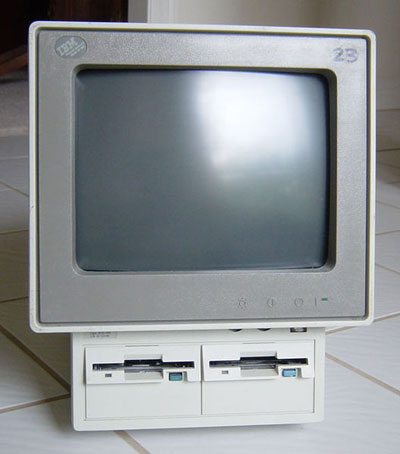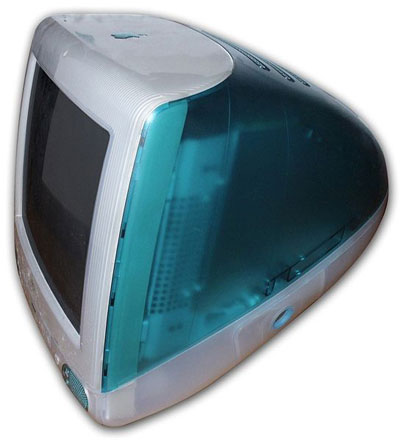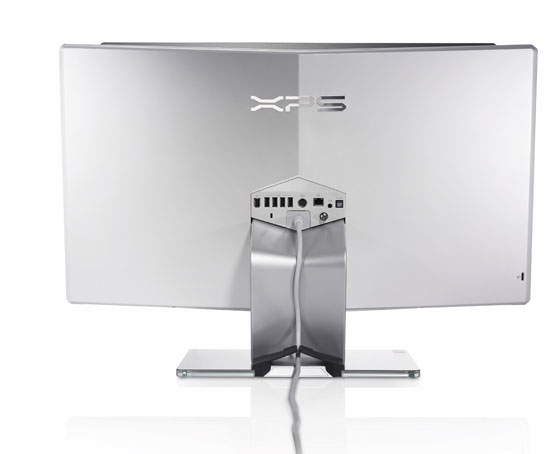The All-in-One Battle: Dell's XPS One 24 vs. Apple's iMac
by Anand Lal Shimpi on October 30, 2008 3:00 PM EST- Posted in
- Systems
The PC industry loves to repeat history. Today's cloud computing trends are nothing more than a rehash of the mainframe architecture of the 1960s 70s right? The use of GPUs as compute accelerators pays homage to a time when general purpose microprocessors were accompanied by additional, off-chip hardware depending on the applications you wanted to run. The issue with both of these statements is that unlike simply repeating history, the PC industry tends to like to improve upon good ideas in history.
At many points during the evolution of the PC we've had what's called the all-in-one, basically a PC with an integrated monitor. Now don't get the all-in-one confused with a notebook, because unlike a notebook the all-in-one is desktop sized and with no battery, it's not intended to be portable.
The point of the all-in-one is to save space, to integrate the monitor into the computer chassis to make it either look better, take up less space, or some combination of the two. Every desktop PC needs a monitor right? So why not integrate the monitor into the PC and sell it as a nice bundle that you simply have to plug in; no messy cables, the OEM gets additional revenue from selling both a display and a PC, and somewhere along the line this benefits the end user.
With each generation of the PC's evolution we went through an all-in-one phase. In the late 80s we had things like the IBM PS/2 that was available in an all-in-one configuration:

The IBM PS/2 Model 25 - courtesy Wikipedia
Apple got hooked on the all-in-one designs and just never seemed to give them up, even when they were dying on the PC side. Remember the awful looking first generation iMac?

The iMac G3 - courtesy Wikipedia
It was different as it was a splash of color in a sea of beige boxes, but Apple couldn't hide the basic limitations of all-in-one PC designs. They are terribly limited from an upgrade standpoint and the biggest issue is that you're stuck with whatever mediocre monitor is integrated into the chassis.
This all started to somewhat change with the later iMacs, mainly thanks to the adoption of decent LCD displays. While the older iMacs and other all-in-ones used CRTs, the move to LCD technology made these things far more attractive. Remembering back to the early days of PC LCDs, there's no way you wanted to be stuck with one of those for any period of time. With LED backlights and far improved black levels, viewing angles and response times, today's LCDs are decent enough where staying married to one for a handful of years isn't too scary a thought.
The other parts of the computer have also gotten smaller, cooler and faster. With the performance delta between desktop and notebook performance shrunk down to simply GPU and I/O differences, it's now possible to build an all-in-one that's just as fast as a modern day desktop. Combine that with a good quality LCD panel and you've got a recipe for an all-in-one that I might actually want to own.
Granted the limitations still exist, these things aren't super upgradeable; while you can add more memory or replace the hard drive, upgrading your video card is usually out of the question as the GPU and its memory are generally soldered onto the motherboard. You can forget about dual-display options, not to mention that if anything ever happens to the display you've got to send the entire machine in for repair. There are many reasons not to consider an all-in-one, but these days having more than one PC in your home isn't unheard of, and PCs are finally stylish and compact enough for them to make an appearance in more unusual locations, places where aesthetics do matter and this is where the modern all-in-one has a purpose.
Dell recently contributed to the all-in-one PC market with its XPS One introduced at the end of 2007. As Dell's attempt to capture some of the iMac market the original XPS One featured a built in 20" widescreen LCD and boasted only needing a single cord for full operation - power. The keyboard, mouse and internet connectivity were all wireless, making it perfect for a very modern setup.
Since the XPS One's release, Apple has updated its iMac line to make it more competitive in terms of pricing and hardware, the top of the line iMac now ships with a 3.06GHz Core 2 Duo processor while last year it shipped with a 2.4GHz part. The XPS One was also at a disadvantage as Dell only offered one panel size at 20" while Apple offered a 20" and a 24". One obvious downside to the all-in-one is that you're stuck with the monitor you bought with the machine, so if you outgrow your 20" you're out of luck. The 24" panel size however seems to be the sweetspot these days, it gives you enough desktop resolution for pretty much everything including full 1080p video playback which is becoming more and more important.
Naturally you know where all of this is headed - Dell is updating the XPS One. It's still called the XPS One but now it's got a 24" panel with a 1920 x 1200 display, some faster hardware and a new (PRODUCT) RED version.

Yeah, it's pretty stylish
I'll dive into specs in a moment but first I figured I'd introduce you two.

Oooh, a plethora of ports
The New XPS One 24
Dell had such clean naming with the XPS One, but tack the number 24 onto the end of it and all of the sudden we're back in silly land again. The 24 obviously denotes the size of the LCD panel used in the XPS One, but don't be fooled, this isn't the same 24" panel that's used in the 2408WFP.
There are four basic configurations that Dell is offering of the XPS One 24, all shipping today:
| Dell XPS One 24 - $1699 | Dell XPS One 24 (PRODUCT) RED- $1699 | Dell XPS One 24 - $1999 | Dell XPS One 24 (PRODUCT) RED- $2299 | |
| CPU | Intel Core 2 Quad Q8200 | Intel Core 2 Quad Q8200 | Intel Core 2 Quad Q8200 | Intel Core 2 Quad Q8200 |
| GPU | Intel GMA X4500 (G45) | Intel GMA X4500 (G45) | NVIDIA GeForce 9600M GT 512MB DDR3 | NVIDIA GeForce 9600M GT 512MB DDR3 |
| Display | 24" 1920 x 1200 | 24" 1920 x 1200 | 24" 1920 x 1200 | 24" 1920 x 1200 |
| HDD | 320GB 7200RPM 3.5" | 320GB 7200RPM 3.5" | 750GB 7200RPM 3.5" | 750GB 7200RPM 3.5" |
| Optical Drive | Slot load DVD+/-RW with double layer write capability | Slot load DVD+/-RW with double layer write capability | Slot load DVD+/-RW with double layer write capability | Slot load Blu-ray Disc burner (Writes to DVD/CD/BD) |
| OS | Windows Vista Home Premium SP1 | Windows Vista Home Premium SP1 | Windows Vista Home Premium SP1 | Windows Vista Ultimate SP1 |
| Price | $1699 | $1699 | $1999 | $2299 |
All four configurations come with an Intel Core 2 Quad Q8200, which is a 45nm Penryn based quad-core processor running at 2.33GHz with a 4MB L2 cache (2MB L2 per core). The smaller amount of cache should put the performance of the Q8200 at below that of a Q6600, but with four cores things like video encoding should go swiftly.
The base configurations ship with Intel integrated graphics (G45), while the upgraded configurations ($1999 and $2299) have a NVIDIA GeForce 9600M GPU, which ships with 32 SPs and a 128-bit memory bus connected to 512MB of DDR3 memory.
The systems either ship with a 320GB or 750GB 7200RPM drive and either a slot loading DL-DVD+/-RW or a Blu-ray read/write drive. All configurations ship with an integrated analog/ATSC tuner. And in a move that Apple could stand to learn from, every last XPS One 24 ships with 4GB of DDR2 memory standard (although with only Vista 32-bit installed on the machine some of that memory does go to waste).
Dell sent me the most expensive configuration, priced at $2299 with all the trimmings, meaning it's got the NVIDIA GPU and the Blu-ray drive. Spec-wise the XPS One 24 is actually pretty decent, it has the potential to be a very quick machine.
If you buy one of the (PRODUCT) RED versions Dell will donate $50 to the (PRODUCT) RED fund against AIDS, buy one of those products with Windows Vista Ultimate and Microsoft will chip in another $30. Given that the RED versions aren't any more expensive than their counterparts the gesture is very nice on Dell's behalf.
And in case you're wondering, the RED versions aren't actually red, they have a metallic white back instead of the standard black.










60 Comments
View All Comments
UpsetAtDell - Saturday, December 19, 2009 - link
Beware ordering a Dell system! I ordered one for my mom for Christmas on Nov 20th with a delivery date of Dec 9th. On the 17th of Dec I was notified that it wouldn't be delivered until Dec 31st, too late for me to set it up for her. After a very difficult time getting through to a customer service representative, I was told that they would not rush the order or rush shipping for me. I had to cancel and buy from a retail store instead. Beware Dell!strikeback03 - Monday, November 3, 2008 - link
Would it kill either of these to have USB ports somewhere more accessible than the back of the device? I plug stuff into my front ports daily. Maybe on a side or behind a door or something? The single-cable look goes away if you have a USB extension hanging out full-time to get a port in a more useful location.Maybe someone here can answer this - how do you make OSX play all the photos in a folder on a USB drive as a slideshow? I brought some photos from an event at work into the main office, and we decided to show them on the head administrator's 24" iMac as it was the largest display around. We could get a slideshow to launch but not play, we ended up launching XP in Parallels to see the photos. Later that night I IMed a friend who uses a Mac, and she didn't know either. Can this really be that hard?
ffakr - Monday, November 10, 2008 - link
Apple's keyboard has an un-powered USB port on each side. It'll run most things.. but it doesn't have the current to run a bus powered 2.5" drive or the like.However, I agree.. the iMac needs to have a more convenient way to access USB. I use a MacBook Pro docked to a Dell 24" and I'm very happy to have 2 USB ports on the right side (and a flash reader!!, come on Apple).
OS X doesn't integrate a slideshow viewer into the Finder like Windows does in Explorer. Apple wants you to import them into iPhoto.
There are several easy ways to view pictures though.. This is generally fine for the owners of a machine but I understand that you just wanted to look at the pics on someone else's computer.
- There is a finder view called CoverFlow. You might be familiar with this in iTunes for Windows. It's also a Finder view and you can scroll the previews as large as you want and flip through the pics like you were shuffling photos on a desktop. You can switch between finder views from the top border of a Finder window.
- Select all the files and open them. Unless you've set .jpgs to open with another app, they should all open in Preview.app which will show you one picture per page (It's the same interface used to render PDFs in OS X).
- Pretty similar.. you can drag the volume (flash drive) or folder full of images onto an app like Preview and it'll open them up. It actually does something cool.. it'll open up photos in sub-folders together in the same window. This is a good reason to have common apps in your Dock.
It's a Mac.. there's probably a half dozen other ways to do this that I can't think of or that I'm not aware of.
As for the Dock argument. There are some cool things you can do with the Dock that you can't do with a task bar, at least I don't think you can do them in Windows. I'm still a 95/98/2000/xp guy.. i've mostly avoided Vista.
- I can drop a folder onto a task bar and access the content by clicking on it. The contents open up in a transparent window. I can drill down into sub directories by holding down the mouse or I can open the directory in a finder window.
- The dock is organized. Permanent shortcuts on the top/left, running apps that aren't always on the dock to the right/bottom of your permanent icons, then a divider bar where folders, doc shortcuts and collapsed App windows go.
- App icons can be stateful. They can give you feedback on your unread mail count (mentioned earlier)...they can have progress bars.. they can even show content including video/animation.
- I don't recall seeing this in any Windows app.. you can right click (command-left click) on a Dock icon and perform App defined things. e.g. I can right click on Mail and select Compose an Email.
rudy - Sunday, November 2, 2008 - link
In this.4wardtristan - Saturday, November 1, 2008 - link
yes a SSD would be a huge improvement over a traditional HDD, but are you (or any one else) ready to fork up the cash to pay for 750GB of SSD space??? (with todays prices)nubie - Sunday, November 2, 2008 - link
I have been running my PCs off of scavenged Tivo HDDs for about 2 years, it doesn't need to be SSD to be unobtrusive.The HDD just needs to not sound like a rock crusher and/or jet engine, not really difficult. But it does require attention and maybe a couple $$.
Ofish - Saturday, November 1, 2008 - link
"...I settled on the latter and simply drug the desktop icon to the Internet menu in the Dock."I couldn't pick up my couch, so instead I simply drug it across the room. lol
I think you mean dragged
nubie - Saturday, November 1, 2008 - link
http://www.merriam-webster.com/dictionary/drug%5B3...">http://www.merriam-webster.com/dictionary/drug%5B3...I don't know, Merriam-Webster has a listing for it, maybe it is best not to complain before checking a dictionary.
I thought this was an interesting review, but I still don't see why they can't put a real PCI-E card in these systems, the Dell is huge (and heavy) with plenty of room for a full-size video card.
Dell needs to pick a quiet hard drive too, this is an area where manufacturers really need to run quality control.
TA152H - Friday, October 31, 2008 - link
Citing the PS/2 Model 25 as an example of an "all in one" computer is about 10 years late to the party. There were many before that, including the TRS-80 Model II, Model III, and Model 4. The Lisa was essentially like that too, unless you count the keyboard, and so was the original Mac.I have all these vintage machines at home, and the PS/2 Model 25 is kind of crappy. PS/2's as a rule were far better made than the rubbish that is sold today, but the Model 25 is the bottom feeder of the line, and is rather inelegant. If you really want a laugh, get your hands on a Model 4P. This monster was supposed to be portable, but it's a real beast. I don't have one though :( .
xyster - Friday, October 31, 2008 - link
Windows vs OSX debate aside, the XPS 24 seems to me like it was designed to be a media center PC, not a gaming machine. The premium speakers, the media center controls on the machine, the trackpad on the keyboard, the choice of a quad-core processor and the choice to use a low-heat producing graphics solution-- its pretty obvious.The iMac on the otherhand, being one of the few desktop choices from Apple, was designed to be more open-ended, for gamers and general use included.
I think the Dell excels at what it was created for, and in that regard it beats out the iMac. With all the other alternatives in the PC market, if someone was looking for a gaming machine, I wouldnt suggest the Dell, but something else, which would excel as a gaming machine. Unlike the Mac market, the PC market has plenty of alternatives.
As a general computing device though, the iMac is a nice computer. I just dont think comparing these two computers to see which is 'best' is correct. Using the Apple as a reference system makes sense, but treat the Dell in the regards for which it was designed for.
Good article overall though. Thanks for posting it.